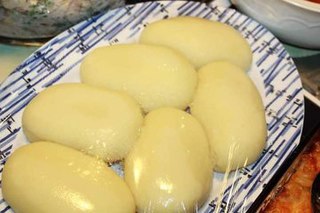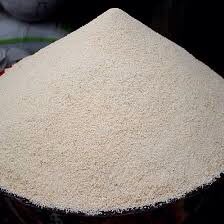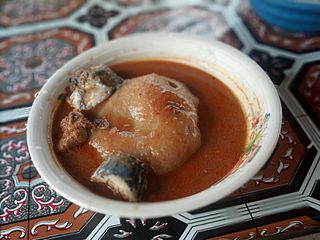Related Research Articles

Tapioca is a starch extracted from the tubers of the cassava plant, a species native to the North and Northeast regions of Brazil, but whose use is now spread throughout South America. It is a perennial shrub adapted to the hot conditions of tropical lowlands. Cassava copes better with poor soils than many other food plants.

Cornmeal is a meal ground from dried corn (maize). It is a common staple food and is ground to coarse, medium, and fine consistencies, but it is not as fine as wheat flour can be. In Mexico, very finely ground cornmeal is referred to as corn flour. When fine cornmeal is made from maize that has been soaked in an alkaline solution, e.g., limewater, it is called masa harina, which is used for making arepas, tamales, and tortillas. Boiled cornmeal is called polenta in Italy and is also a traditional dish and bread substitute in Romania.

Glutinous rice is a type of rice grown mainly in Southeast and East Asia, and the northeastern regions of South Asia, which has opaque grains, very low amylose content, and is especially sticky when cooked. It is widely consumed across Asia.

Malay cuisine is the traditional food of the ethnic Malays of Southeast Asia, residing in modern-day Malaysia, Indonesia, Singapore, Brunei, Southern Thailand and the Philippines as well as Cocos Islands, Christmas Island, Sri Lanka and South Africa.

Fufu is a pounded meal found in West African cuisine. It is a Twi word that originates from the Akans in Ghana. The word has been expanded to include several variations of the pounded meal found in other African countries including Sierra Leone, Guinea, Liberia, Cote D'Ivoire, Burkina Faso, Benin, Togo, Nigeria, Cameroon, the Democratic Republic of Congo, the Central African Republic, the Republic of Congo, Angola, and Gabon. It also includes variations in the Greater Antilles, where African culinary influence is high.

Ugali, also known as posho, nsima, and other names, is a type of corn meal made from maize or corn flour in several countries in Africa. It is cooked in boiling water or milk until it reaches a stiff or firm dough-like consistency. In 2017, the dish was added to the UNESCO Representative List of the Intangible Cultural Heritage of Humanity, one of a few foods in the list.

Ainu cuisine is the cuisine of the ethnic Ainu in Japan and Russia. The cuisine differs markedly from that of the majority Yamato people of Japan. Raw meat like sashimi, for example, is rarely served in Ainu cuisine, which instead uses methods such as boiling, roasting and curing to prepare meat. Also unlike Japanese cuisine, traditional Ainu cuisine did not use miso, soy sauce, or sugar, though these seasonings make an appearance in modern Ainu cuisine. The island of Hokkaidō in northern Japan is where most Ainu live today; however, they once inhabited most of the Kuril islands, the southern half of Sakhalin island, and parts of northern Honshū Island.

In West Africa, garri is the flour of the fresh starchy cassava root.

A purée is cooked food, usually vegetables, fruits or legumes, that has been ground, pressed, blended or sieved to the consistency of a creamy paste or liquid. Purées of specific foods are often known by specific names, e.g., apple sauce or hummus. The term is of French origin, where it meant in Old French purified or refined.

A rice cake may be any kind of food item made from rice that has been shaped, condensed, or otherwise combined into a single object. A wide variety of rice cakes exist in many different cultures in which rice is eaten. Common variations include cakes made with rice flour, those made from ground rice, and those made from whole grains of rice compressed together or combined with some other binding substance.

The cuisine of the Democratic Republic of the Congo and the Republic of the Congo varies widely, representing the food of indigenous people. Cassava, fufu, rice, plantain and potatoes are generally the staple foods eaten with other side dishes.

A fishcake is a culinary dish consisting of filleted fish or other seafood minced or ground, mixed with a starchy ingredient, and fried until golden.

Nigerian cuisine consists of dishes or food items from the hundreds of Native African ethnic groups that comprises Nigeria. Like other West African cuisines, it uses spices and herbs with palm oil or groundnut oil to create deeply flavored sauces and soups.

A great variety of cassava-based dishes are consumed in the regions where cassava is cultivated, and the ingredient is included many national or ethnic specialities.

Sundanese cuisine is the cuisine of the Sundanese people of Western Java, and Banten, Indonesia. It is one of the most popular foods in Indonesia. Sundanese food is characterised by its freshness; the famous lalab eaten with sambal and also karedok demonstrate the Sundanese fondness for fresh raw vegetables. Unlike the rich and spicy taste, infused with coconut milk and curry of Minangkabau cuisine, the Sundanese cuisine displays the simple and clear taste; ranged from savoury salty, fresh sourness, mild sweetness, to hot and spicy.

Malawian cuisine includes the foods and culinary practices of Malawi. Tea and fish are popular features of Malawian cuisine. Sugar, coffee, corn, potatoes, sorghum, cattle and goats are also important components of the cuisine and economy.
Pará cuisine refers to the traditional cuisine native to Pará, Brazil. Foods from this region primarily draw influence from Indian, African, and Portuguese cultures. The core ingredients are sourced from the Amazon jungle, and may include meats such as shrimp, crab, seafood, fish, poultry, bush meat, and duck; these are all cooked with leaves, peppers, and herbs. Dishes are cooked in clay pots or barbecued in moquéns and soaked in tucupi, a yellow sauce extracted from wild manioc root native to the Amazon. Dishes may be served in bowls, in containers of clay, wrapped in cocoons of banana leaves, or in urupemas.

Kokonte, also known as abeti3, lapiiwa, lapelawa or “face the wall”, is a staple swallow food eaten in some parts of Africa including Togo, Ghana and others. In Ghana, kokonte is eaten by most of the ethnic groups like the Ga, Akan, Hausa, Kokonte usually is brown, grey and deep green depending on the type of ethnic group that prepares the dish. Kokonte is usually prepared out of dried cassava or yam.

Zambian cuisine offers a range of dishes, which primarily features Nshima, a staple thick porridge crafted from maize flour, locally known as mealie meal. Nshima itself is quite plain, but it is typically accompanied by an array of traditional Zambian side dishes that introduce a spectrum of flavors to the meal.
References
- ↑ The World Cassava Economy: Facts, Trends and Outlook. Food & Agriculture Org. 1 January 2000. pp. 24–. ISBN 978-92-5-104399-8.
- ↑ Michael M'tisunge Phoya (2008). Walks of Life: The Other Side of Malawi. IITA. pp. 29–. ISBN 978-99908-941-0-3.